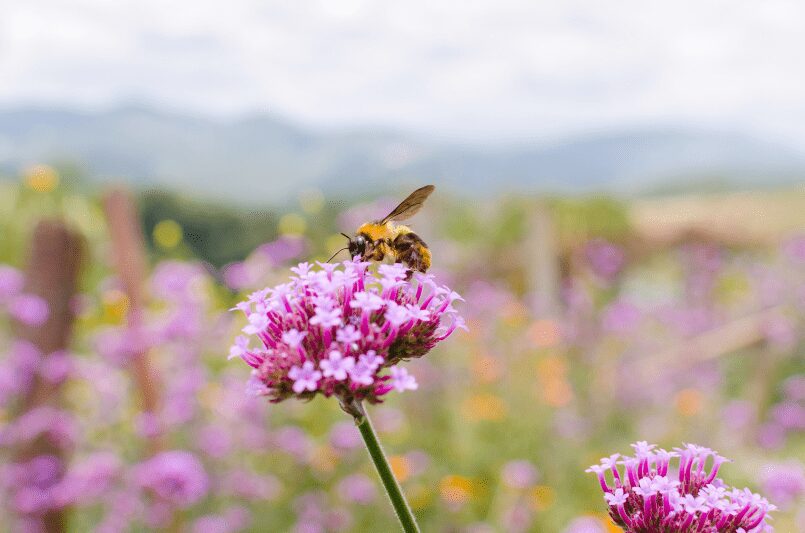
To get your garden buzzing with activity, you must add bees to the list of things to do. Bees are a great addition to the ecosystem and can help reduce your need for pesticides and other horticultural supplies. Here are five ways to get bees to your garden in a hurry!
If your natural reaction to that oncoming low buzzing sound is to run, there’s no need to panic because bees are gentle and beneficial creatures. A seasoned gardener would know that having a few visit your garden is essential for its ecosystem because of their natural inclination to pollinate your plants.
To attract more bees to your garden, creating a safe environment where they can get plenty of food is essential. But building a bee-friendly garden can take a bit of planning; that’s why below is an easy guide you can follow.
Why attract bees to your garden?
Bees are one of the most significant pollinators in nature, so having them in your garden can be beneficial. Having them around will diversify your flora since they carry pollen from one plant to another to help them reproduce. As a result, the flowers will produce seeds you can sow to grow more plants and make.
But because of modern agricultural techniques, the population and varieties of bees have been dwindling. That’s why creating a haven for bees in your yard can be helpful because it can give them steady food and a safe space to nest.
How do you Get Bees To Your Garden?
If you want to increase the population of bees that frequent your garden, here are a few steps you can do to attract them, according to Rob Frankson from Wild Yards:
Grow bee-friendly plants
Having a diverse variety of plants is probably the most effective way to get bees into your garden to provide them with a sufficient supply of nectar and pollen to feed on. It would also be helpful to grow plants native to your region since bees will be more familiar with them.
Flowering trees and shrubs like hawthorn, hazelnut, and blueberry bushes are great since they can yield plenty of blooms with just one plant. Since bees are drawn to their flowers, growing herbs like thyme, basil, oregano, and sage wouldn’t hurt.
Select vibrant flowers
Having a selection of colorful flowers is suitable to make your garden more inviting. Since bees are more attracted to blue, violet, and yellow flowers, you might consider planting marigolds, sunflowers, zinnias, and lupines.
Considering the shapes of the flowers can also be beneficial, so you can attract different varieties of bees. For instance, bumblebees prefer tubular flowers like foxglove and honeysuckle because of their long tongues. At the same time, furrow bees would go for daisies and sunflowers since they have shorter tongues.
Although most species of bees are more active during spring and summer, it’s better to plant flowers that can bloom in different seasons to keep pollinators returning to your yard.
Avoid using chemicals
Chemical insecticides and weed killers may be effective for maintaining your garden, but they harm bees. Systemic insecticides are hazardous because the plants absorb them into their system. As a result, their nectar and pollen will turn poisonous and kill a bee quickly once it feeds on them.
If you want to keep pests away from your plants while still attracting bees to your garden, you should research organic insecticides that you can use instead.
Provide bee shelter
Placing bee shelters around your garden can encourage them to visit more often since these can protect against the elements and other predators. It can also be a safe nesting area for these solitary creatures since they’re secluded from the wild.
You can drill holes in hollow wood blocks or stack open cardboard into a container to create a bee shelter. Since this will provide a home for several bees, it’s often called a ‘bee hotel.’ But if you don’t have time to DIY your habitat, you can buy ready-made pieces from garden shops or online.
Elevate them above the ground so predators can’t reach them. The bees would also appreciate it if you could position their hotel facing the morning sunlight so they can warm up their bodies during the day.
Set up a watering station.
Like all creatures, bees can also get dehydrated, so leaving a small amount of water available is good. A basin of fresh water daily can be enough as a hydrating treat for these busy bees. But don’t forget to place a few floating corks or stones inside to give the bees a place to land.
You can also employ self-filling pet water containers, so you don’t have to check their water level constantly. Using hummingbird feeders is also a great idea; fill them with water instead of sugar syrup.

























